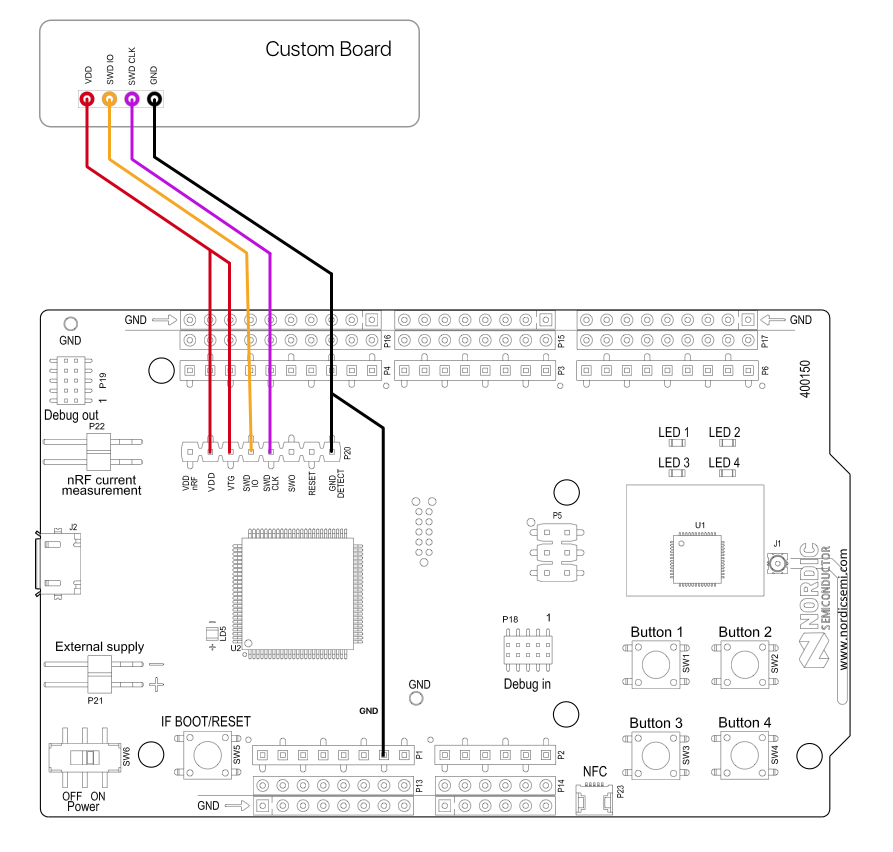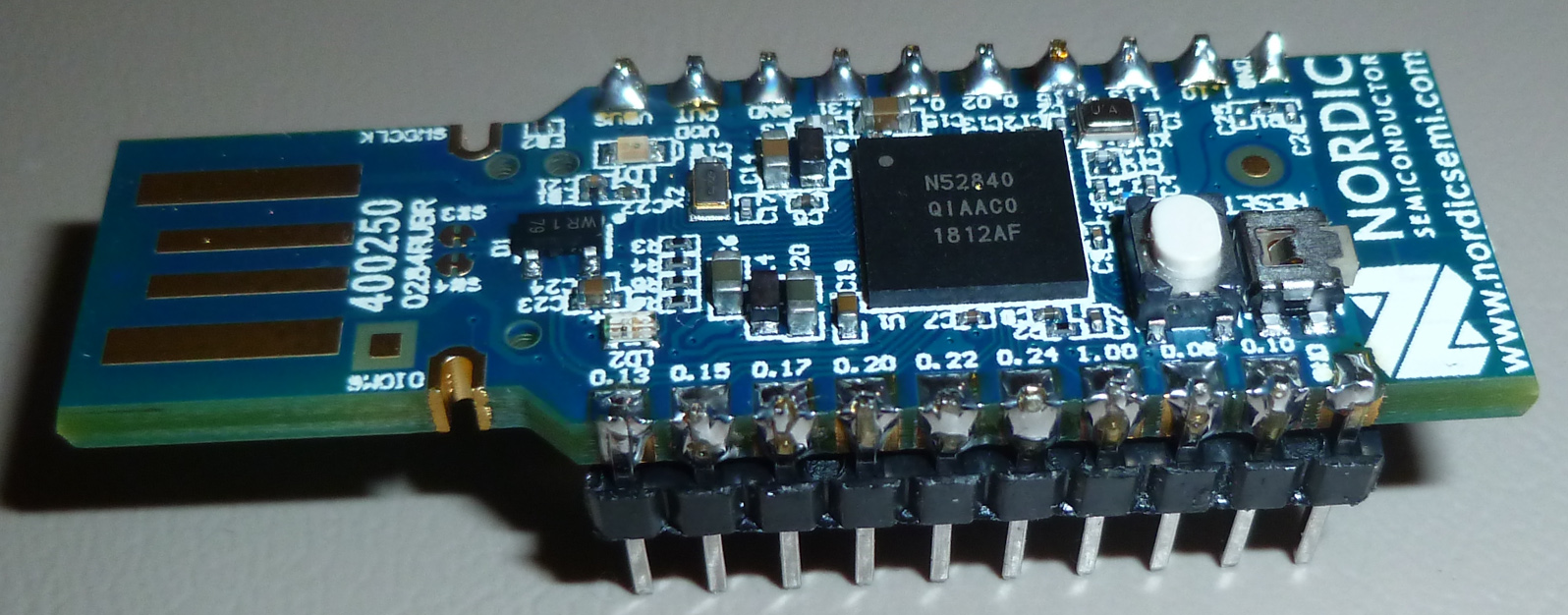Everything nRF52840
-
@neverdie interesting research and ideas. Have you tried to get BLE 5.0 running (the S140 SD) or using the nrf52840 radio features (best with long range) so that we can consider a sensor node/actor and does the sleep properly work? There are some basic features which have to work before switching the development/runtime env.
I haven't been working on that per se, but I do have a REPL over radio working: https://github.com/rabbithat/nRF52_wireless_Forth_REPL
which can also be used for doing OTA code updates. -
I haven't been working on that per se, but I do have a REPL over radio working: https://github.com/rabbithat/nRF52_wireless_Forth_REPL
which can also be used for doing OTA code updates.@NeverDie You doing a great research! I have quickly checked your REPL code and the radio lib.
So you have implemented a OSI Layer 3+4 (Transport Layer with IP/TCP Stack).
I'm wondering if/how this can be used to complay to BLE 5.0 (long range), ZigBee and Threads which the new Nordic SDK (Zigbee and Threads 2.0) offers? Are they also using the Softdevice S140 (6.1) libs or ...?
There is a ZigBee OTA update example provided by Nordic (but I have not yet enogh time to test it).
Currently, I'm still using MySensors and the NRF5_ESP (Nordic private) protocol which works. IT would be also interesting to use a more industry standard protocol like ZigBee or THREADS which seem to be also supported by OpenHAB.
I'll certainly do further investigations in this direction. I have tried to test it with Segger Embedded studio and also with IAR Studio for ARM (the second requires some newer 32Bit version libs from Nordic and an internat request for that was raised already). Segger works fine with the J-Link adapters. -
@NeverDie You doing a great research! I have quickly checked your REPL code and the radio lib.
So you have implemented a OSI Layer 3+4 (Transport Layer with IP/TCP Stack).
I'm wondering if/how this can be used to complay to BLE 5.0 (long range), ZigBee and Threads which the new Nordic SDK (Zigbee and Threads 2.0) offers? Are they also using the Softdevice S140 (6.1) libs or ...?
There is a ZigBee OTA update example provided by Nordic (but I have not yet enogh time to test it).
Currently, I'm still using MySensors and the NRF5_ESP (Nordic private) protocol which works. IT would be also interesting to use a more industry standard protocol like ZigBee or THREADS which seem to be also supported by OpenHAB.
I'll certainly do further investigations in this direction. I have tried to test it with Segger Embedded studio and also with IAR Studio for ARM (the second requires some newer 32Bit version libs from Nordic and an internat request for that was raised already). Segger works fine with the J-Link adapters.@heinzv said in Everything nRF52840:
I'm wondering if/how this can be used to complay to BLE 5.0 (long range), ZigBee and Threads which the new Nordic SDK (Zigbee and Threads 2.0) offers? Are they also using the Softdevice S140 (6.1) libs or ...?
If you specifically want those protocols, then at present the Nordic SDK is the only existing library I know of that will get you them.
-
It appears that Fanstel is now selling the amplified nRF52840 modules:
https://www.fanstel.com/bt840f-nrf52840-ble-5-module-secure-iot-802154-thread-zigbee-1 -
Wait, what? The nRF52840 can now act as a Zigbee device too??
So I could make Arduino projects that talk Zigbee?
-
Wait, what? The nRF52840 can now act as a Zigbee device too??
So I could make Arduino projects that talk Zigbee?
@alowhum Well, 802.15.4 for sure. I already did it, as I reported earlier. Beyond that, there's no native on-chip support for Zigbee per se. Maybe they confused it with zigbee? https://www.electronicdesign.com/what-s-difference-between/what-s-difference-between-ieee-802154-and-zigbee-wireless
That said, someone could certainly write a zigbee on top of it. It's meant for stuff like that. I imagine Thread is already written on top of it.
Anyway, I suspect that the amplified nRF52840 modules will be as good as it gets for quite some time and will remain relevant for years to come. The long wait is finally over!
-
By the way, I now have the wireless FORTH REPL working on the same nRF52840-dongle as in the OP of this thread: https://github.com/rabbithat/nRF52840-Dongle_hex/blob/master/README.md
I can plug the dongle into any USB port to power it, and with the wireless REPL the experience is exactly the same as if I had a wired serial connection to the dongle. I can interact with the REPL, start programs, load code or updates, and/or debug--all wirelessly. If you want to try it, I have getting started instructions in the github repository.
-
Someone know if exist a usb nRF52840-dongle (with external antenna ) to plug into a raspberry to scan nearby tag?
-
@blademckain The Micro:bit comes close.
-
The new Arduino Nano 33 BLE is going to use the nrf52840. It will be interesting to see how support for the nrf52840 evolves in the Arduino environment.
-
The new Arduino Nano 33 BLE is going to use the nrf52840. It will be interesting to see how support for the nrf52840 evolves in the Arduino environment.
-
Arduino Nano 33 BLE code is coming out. It's going to be based on MBED. Here's a discussion on the Arcuino Blog:
https://blog.arduino.cc/2019/07/31/why-we-chose-to-build-the-arduino-nano-33-ble-core-on-mbed-os/I think it is interesting that no one has updated Sandeep Mistry's code for the NRF52840. Since it has been so long, I'm guessing this is not an easy task.
-
Arduino Nano 33 BLE code is coming out. It's going to be based on MBED. Here's a discussion on the Arcuino Blog:
https://blog.arduino.cc/2019/07/31/why-we-chose-to-build-the-arduino-nano-33-ble-core-on-mbed-os/I think it is interesting that no one has updated Sandeep Mistry's code for the NRF52840. Since it has been so long, I'm guessing this is not an easy task.
-
Someone may get some reuse out of this. I've made a 3d printed prototyping rig for the NRF52840 DK board as part of my MySensors adventures....
https://www.thingiverse.com/thing:3836487


-
Arduino Nano 33 BLE code is coming out. It's going to be based on MBED. Here's a discussion on the Arcuino Blog:
https://blog.arduino.cc/2019/07/31/why-we-chose-to-build-the-arduino-nano-33-ble-core-on-mbed-os/I think it is interesting that no one has updated Sandeep Mistry's code for the NRF52840. Since it has been so long, I'm guessing this is not an easy task.
@nagelc I think Sandeep Mistry is working on new arduino core, based on mbed. As you can see he is titled as "Senior Software Engineer at Arduino" here. So I guess Mysensors community would need to move to new core eventually, or to fork Sandeep's core and develop it alone. I would prefer the first choice.
-
@monte
I remember in first place they mentioned apache mynewt a while ago, but finally they are moving to mbed.. still nice to hear. I think this new arduino/mbed core has not everything yet for running MySensors, that needs some work on proprietary rf.., whereas there are other working cores. At least for short-mid term. There are so much nice things to improve or add on todolist.
Team knows about new mcus, new cores etc :nerd_face: what's missing is time, resources vs real life and projects! -
@monte
I remember in first place they mentioned apache mynewt a while ago, but finally they are moving to mbed.. still nice to hear. I think this new arduino/mbed core has not everything yet for running MySensors, that needs some work on proprietary rf.., whereas there are other working cores. At least for short-mid term. There are so much nice things to improve or add on todolist.
Team knows about new mcus, new cores etc :nerd_face: what's missing is time, resources vs real life and projects!@scalz With official support from arduino and massive amount of chinese clone boards and much more powerful hardware I think in a year new nano board can become a new standard. Not to mention that single board which already has everything to work with mysensors is something many people where looking for for years.
I understand the time constrains, and am always thankful for a dev's work for community's good :) -
@monte sure would be nice, no need to argue on this, about a standard. (still not sure imho if 2.4g would be best choice). I'm wondering if adafruit will give up on all the work they made on their custom core too (I imagine they have no hurry, and wait to see if that'll be promising).
let's see what will happen. and perhaps next year there will be new better mcus again, almost sure :grin: -
@neverdie I admit that I also powered the module via the DK because it takes less than 20mA. I used this connection description:

But I'll try to use a complete an external PS next time and see if it makes a difference.@heinzv Sorry to cut-in with an unrelated comment, but can you tell me how or from where you got this nice schematic diagram? I am looking for one that has other cards such as Raspberry Pi and TI cards for an architectural diagram
Cheers

